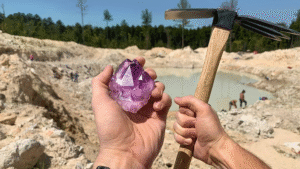
Estimated reading time :
April 17, 2025 10:51 am
Geologist vs Gemologist take on amethyst
Writer’s Name :
Date of Publishing :
Writer’s Name :
Arya
Estimated reading time :
Any gemstone is not viewed with only one angle. There are geologists and gemologists who view stones from a very different perspective. They both study the earth and its composition but have a slightly different take on some aspects. Before we get on to knowing how geologists vs. gemologists look at amethyst, we have to learn a little about them as well. Here’s how they both work :
| Geologist | Gemologist | |
|---|---|---|
| Definition | An academically trained scientist with a strong background in geology—the study of the composition and formation of the Earth and other planetary bodies | A specialist with formal education who is capable of identifying, analyzing, and assessing gemstones, certain rocks, soft minerals, and some organic materials. |
| Focus of coursework | Numerous fields are studied by geologists, such as hydrogeology, engineering geology, geochemistry, geophysics, and paleontology. | They focus on mastering gemstone analysis, which also includes amethyst mineral composition. |
| Tasks | Geologists look for precious metals, natural gas, and petroleum. They research landslides, tsunamis, volcanoes, and earthquakes. In planetary geology, planetary body sampling and analysis are managed by remote telemetry. | Identification by spectroscopy, inclusions, specific gravity, and refractive index is the main focus of gemologists. |
| Tools used | Rock hammer, hand lens, notebooks/clipboard, pencil magnet, small acid bottle, retractable knife or Mohs hardness testing kit, scales, compass, and GPS | Specific gravity testing liquids, Mohs hardness points, ultraviolet (UV) light, and a stereo microscope |
Let’s have a look at how they view amethyst differently:
Geologist’s perspective: Amethyst in geology is considered as a mineral, and their primary focus is on its occurrence, formation, and geological context. This is how they study the stone:
- Crystal structure and properties: They examine the stone’s growth patterns and color differences that are brought on by geological circumstances and crystal lattice.
- Formation and Composition: They study how amethyst formation takes place in volcanic rocks, geodes, and hydrothermal veins. They also study its chemical composition.
- Geological environments: They locate amethyst reserves in places like Brazil, Uruguay, and Zambia and research the geological mechanisms that produce them.
- Dating and analysis: They figure out the age and background of amethyst formations using spectroscopic and radiometric dating.

Gemologists perspective: They look at amethyst as a gemstone and focus primarily on its grading, quality, and commercial value. This is how they study the stone:
- Cut and Shape: They examine the ways in which various cuts improve market appeal and brilliance.
- Color and Clarity: They assess the purple color’s strength and coherence and look for additions that could compromise transparency.
- Treatment and Enhancement: They recognize synthetic or heat-treated amethyst and differentiate between lab-made and natural stones.
- Authentication and Valuation: They use instruments such as microscopes, spectrometers, and refractometers to ascertain market value and confirm authenticity.
That’s how gemologists and geologists look at amethyst. You can also check out this video to see some more interesting insights.

You may also like


People also search for
| Geologist | Gemologist | |
|---|---|---|
| Definition | An academically trained scientist with a strong background in geology—the study of the composition and formation of the Earth and other planetary bodies | A specialist with formal education who is capable of identifying, analyzing, and assessing gemstones, certain rocks, soft minerals, and some organic materials. |
| Focus of coursework | Numerous fields are studied by geologists, such as hydrogeology, engineering geology, geochemistry, geophysics, and paleontology. | They focus on mastering gemstone analysis, which also includes amethyst mineral composition. |
| Rose de France | $20-40 | Light lilac to pink |
| Rose de France | $20-40 | Light lilac to pink |
| Geologist | Gemologist | |
|---|---|---|
| Definition | An academically trained scientist with a strong background in geology—the study of the composition and formation of the Earth and other planetary bodies | A specialist with formal education who is capable of identifying, analyzing, and assessing gemstones, certain rocks, soft minerals, and some organic materials. |
| Focus of coursework | Numerous fields are studied by geologists, such as hydrogeology, engineering geology, geochemistry, geophysics, and paleontology. | They focus on mastering gemstone analysis, which also includes amethyst mineral composition. |
| Rose de France | $20-40 | Light lilac to pink |
| Rose de France | $20-40 | Light lilac to pink |
